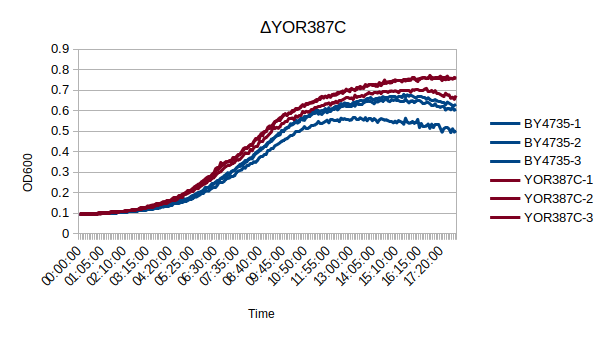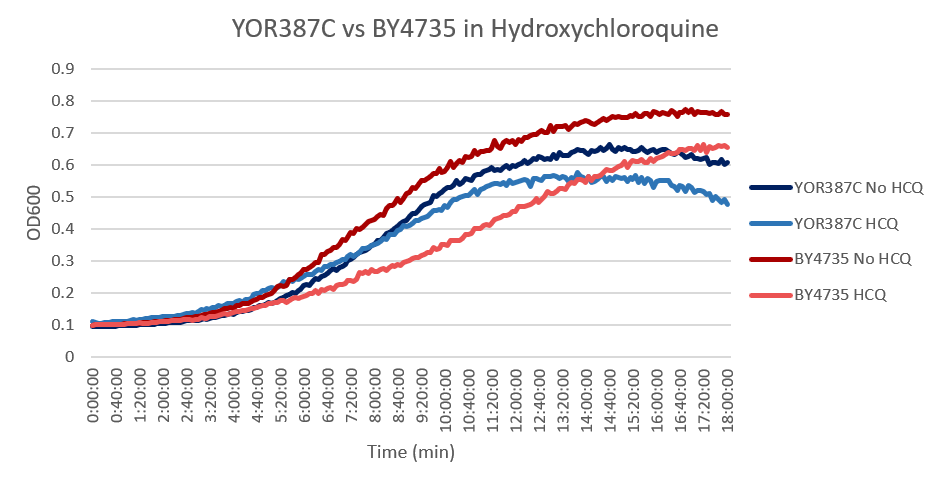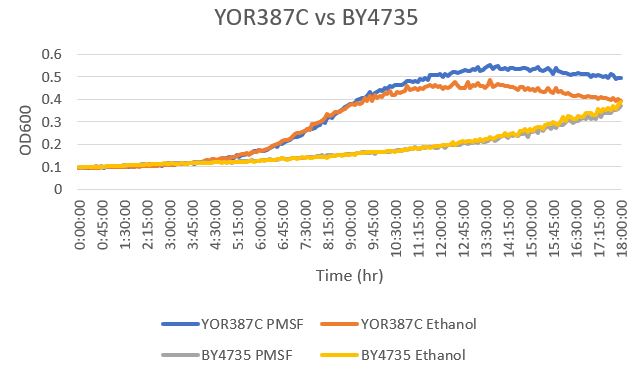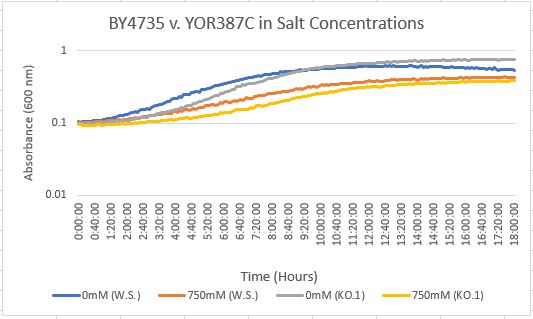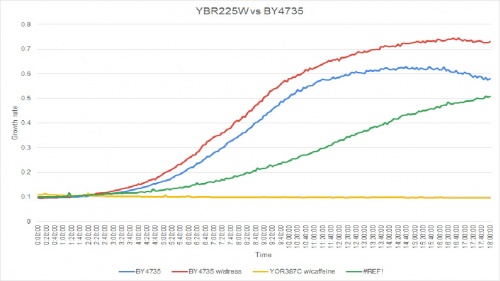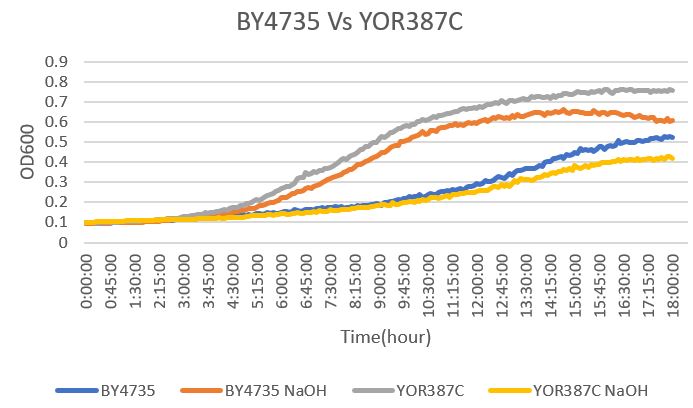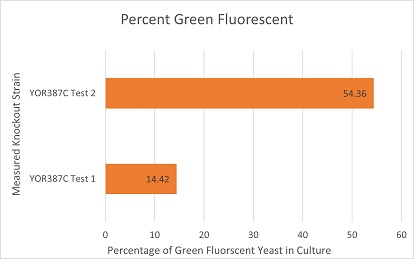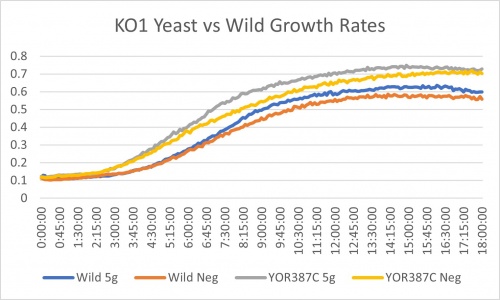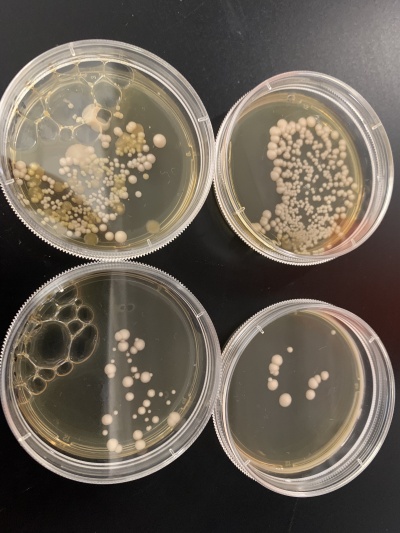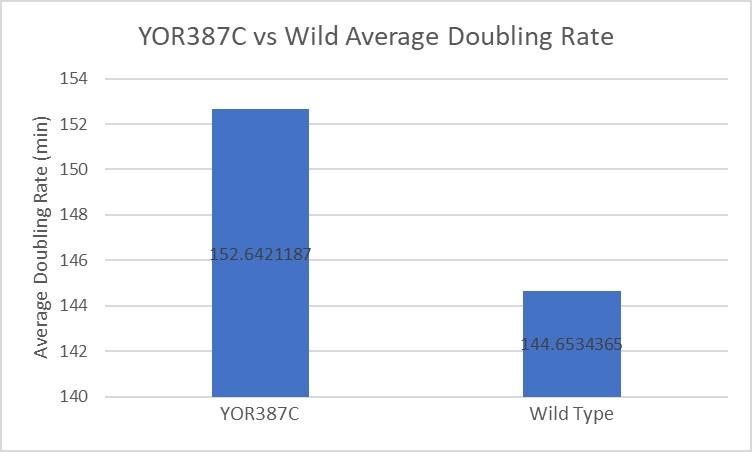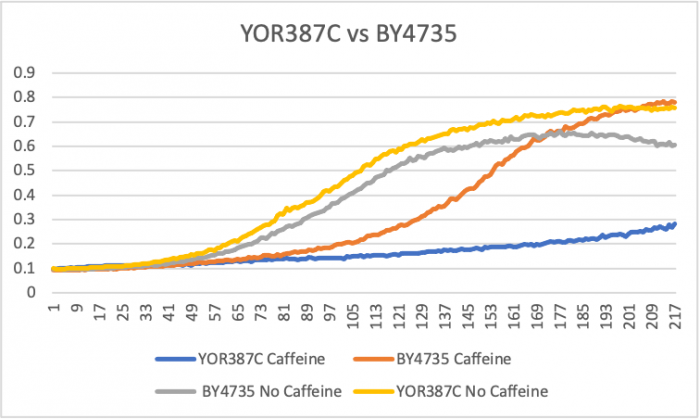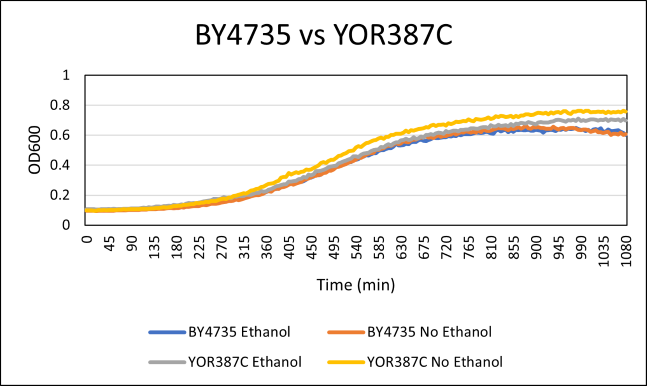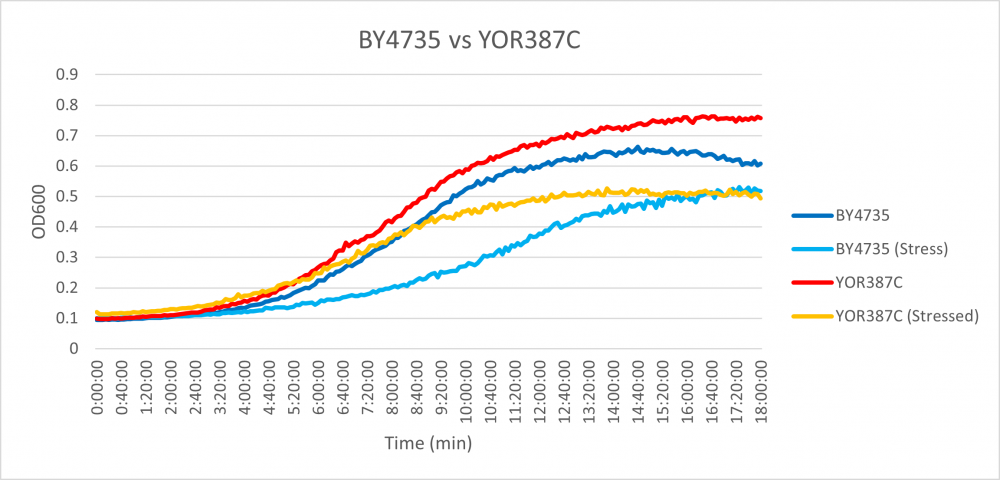Difference between revisions of "YOR387C"
(→Doubling Time at 0.25 concentration) |
|||
| (34 intermediate revisions by the same user not shown) | |||
| Line 40: | Line 40: | ||
===[[UW-Stout/Hydroxychloroquine_SP21|Hydroxychloroquine]]=== | ===[[UW-Stout/Hydroxychloroquine_SP21|Hydroxychloroquine]]=== | ||
| − | [[Image:YOR387C.png]] | + | [[Image:YOR387C-BY4735.png]] |
| − | Under normal conditions, the | + | Under normal conditions, the BY4735 doubling time is 144 minutes, while that of YOR387C is 158 minutes. On average, the YOR387C lag phase was slightly longer than that of BY4735 under normal conditions. When grown in an environment with hydroxychloroquine, YOR387C doubled in 249 minutes, while BY4735 doubled in 276 minutes. This shows that hydroxychloroquine inhibits BY4735 slightly more than YOR387C. (These doubling times and curves are the means of three experiments.) |
| + | |||
| + | ===[[UW-Stout/PMSF SP21|Phenylmethylsulphonyl Fluoride]]=== | ||
| + | [[File:YOR387C vs Wild type.jpg]] | ||
| + | |||
| + | The YOR387C yeast gene was effected drastically by the addition of PMSF. With a doubling time of 150 minutes with the PMSF present, it did better than the wild type yeast strain. I speculate this is because the gene made the cells more resistant to breakdown by cell lysis. The wild type had a doubling time of 382 minutes, meaning that the YOR387C yeast gene strain was effective in growing nearly 3 times as fast. The doubling time of the YOR387C yeast strain was 182 minutes, and the doubling time of the BY4735 yeast strain was 442 minutes. | ||
<!-- PLEASE ADD Community Commentary ABOVE THIS MESSAGE. See below for an example of community annotation --> | <!-- PLEASE ADD Community Commentary ABOVE THIS MESSAGE. See below for an example of community annotation --> | ||
| Line 80: | Line 85: | ||
Doubling time of BY4735 without caffeine: 187 minutes | Doubling time of BY4735 without caffeine: 187 minutes | ||
| + | |||
| + | ===[[UW-Stout/Sodium Hydroxide SP21|Sodium Hydroxide]]== | ||
| + | [[File:YOR V WT.jpg]] | ||
| + | |||
| + | The YOR387C strain was effected by NaOH, with a doubling time of 516 minutes with NaOH. This determines that the lysis of the cell could withstand the base NaOH and could still replicate effectively. With just water, the YOR387C strain doubling time was 360 minutes. The doubling time for the BY4735 strain with NaOH was 545 minutes, and with just water the BY4735 strain was 809 minutes. | ||
<!-- PLEASE ADD Community Commentary ABOVE THIS MESSAGE. See below for an example of community annotation --> | <!-- PLEASE ADD Community Commentary ABOVE THIS MESSAGE. See below for an example of community annotation --> | ||
| Line 115: | Line 125: | ||
---- | ---- | ||
===[[UW-Stout/Calcofluor White SP21|Calcofluor White]]=== | ===[[UW-Stout/Calcofluor White SP21|Calcofluor White]]=== | ||
| + | [[Image:YOR387C CW.jpg|YOR387C CW]] | ||
| + | From this data we can determine that there was a moderate growth inhibition on this strain of yeast. The modified yeast had a doubling rate that was eight minutes longer than the wild type on average, and when compared to the effect on other yeast strains this is a small difference, but not insignificant. | ||
---- | ---- | ||
| + | ===[[UW-Stout/Caffeine 2 SP21|Caffeine Group 2]]=== | ||
| + | [[File:YOR387C graph.png|700px]] | ||
| + | ====Doubling Time at 0.25 concentration==== | ||
| + | Wild Type w/ caffeine Td = (146-66) x ln(2)/ln(.6/.2) = 88 minutes; Wild Type no caffeine Td= (113-13) x ln(2)/ln(.5/.1)= 34 minutes; YOR387C w/ caffeine Td = (199-1) x ln(2)/ln(0.25/0.1) = 150 minutes ; YOR387C no caffeine Td= (121-25) x ln(2)/ln(.6/.1)= 37 minutes; These doubling times show that the 0.25 mM concentration in YOR387C slowed down the rate of growth. The caffeine was able to slow down metabolic activity. Caffeine may effect the function of the Rad52 protein that aids in DNA double-stranded breaks and maintaining genome stability. The caffeine may also aid in the process of the cell protecting itself from reacting oxygen species. Since the concentration is small in volume, apoptosis was not induced for cell function. | ||
==[[UW-Stout/Heat Shock SP21|Heat Shock]]== | ==[[UW-Stout/Heat Shock SP21|Heat Shock]]== | ||
| Line 123: | Line 139: | ||
The YOR387C yeast gene was effected greatly by the heat shocking from the thermal cycler. As can be seen in the visual, the controlled plate (non-heat shocked) essentially grew a thick blanket of very tiny DNA colonies throughout the entire plate. Both trials of the actual heat shocked plates resembled roughly the same outcome. Both grew very small amounts of medium-sized colonies. This basically means that this strain was fragile and the heat killed off most of the potential colonies while being grown. | The YOR387C yeast gene was effected greatly by the heat shocking from the thermal cycler. As can be seen in the visual, the controlled plate (non-heat shocked) essentially grew a thick blanket of very tiny DNA colonies throughout the entire plate. Both trials of the actual heat shocked plates resembled roughly the same outcome. Both grew very small amounts of medium-sized colonies. This basically means that this strain was fragile and the heat killed off most of the potential colonies while being grown. | ||
| + | |||
| + | ===[[UW-Stout/Ethanol Sensitivity| Ethanol Sensitivity]]=== | ||
| + | [[File:YOR387C Ethanol.png]] | ||
| + | |||
| + | The YOR387C yeast strain was determined to have an average doubling time of 216 minutes, which is only slightly higher to the doubling time of the BY4735 strain, at 182 minutes. The doubling time of the BY4735 strain when exposed to 9ethanol is 218 minutes, and the doubling time of the YOR387C strain is 290 minutes when exposed to 9% concentration of ethanol. Ethanol does not seem to impact either of these strains too drastically in terms of one being more or less sensitive to this stress. | ||
| + | |||
| + | [[https://wiki.yeastgenome.org/index.php/UW-Stout/Ethanol_SP21]] | ||
| + | |||
| + | == Hydroxyurea == | ||
| + | [[File:growthratestress.png|center|thumb|1000px|]] | ||
| + | |||
| + | The YOR387C strain was to have an average doubling time of 183 minutes, which was slightly higher than the doubling time of the BY4735 strain, with 182 minutes. The doubling time of the BY4735 strain when exposed to hydroxyurea was 289 and a half minutes and the doubling time of the YOR387C strain 269 minutes. Hydroxyurea seems to impact these strains slightly in terms of being more sensitive to this stress, but overall not a drastic impact. | ||
| + | [https://wiki.yeastgenome.org/index.php/UW-Stout/Hydroxyurea_SP21] | ||
==References== | ==References== | ||
Latest revision as of 06:49, 5 May 2021
Share your knowledge...Edit this entry! <protect>
| Systematic name | YOR387C |
| Gene name | |
| Aliases | |
| Feature type | ORF, Uncharacterized |
| Coordinates | Chr XV:1070241..1069621 |
| Primary SGDID | S000005914 |
Description of YOR387C: Putative protein of unknown function; regulated by the metal-responsive Aft1p transcription factor; highly inducible in zinc-depleted conditions; localizes to the soluble fraction[1][2][3]
</protect>
Community Commentary
About Community Commentary. Please share your knowledge!
This gene is part of the UW-Stout Orphan Gene Project. Learn more here.
Growth Curve
In a BY4735 background, knocking out YOR387C does not seem to have much effect on the strain's growth rate. In this experiment, the BY4735 strain's doubling time was 162 minutes, while the YOR387C knock-out strain's doubling time was 137 minutes. (These doubling times are the means of three experiments.)
Hydroxychloroquine
Under normal conditions, the BY4735 doubling time is 144 minutes, while that of YOR387C is 158 minutes. On average, the YOR387C lag phase was slightly longer than that of BY4735 under normal conditions. When grown in an environment with hydroxychloroquine, YOR387C doubled in 249 minutes, while BY4735 doubled in 276 minutes. This shows that hydroxychloroquine inhibits BY4735 slightly more than YOR387C. (These doubling times and curves are the means of three experiments.)
Phenylmethylsulphonyl Fluoride
The YOR387C yeast gene was effected drastically by the addition of PMSF. With a doubling time of 150 minutes with the PMSF present, it did better than the wild type yeast strain. I speculate this is because the gene made the cells more resistant to breakdown by cell lysis. The wild type had a doubling time of 382 minutes, meaning that the YOR387C yeast gene strain was effective in growing nearly 3 times as fast. The doubling time of the YOR387C yeast strain was 182 minutes, and the doubling time of the BY4735 yeast strain was 442 minutes.
Salt Concentration (NaCl)
0mM NaCl conc. BY4735 strain's doubling time: 169 minutes
0mM NaCl conc. YOR387C strain's doubling time: 129 minutes
750mM NaCl conc. BY4735 strain's doubling time: 294 minutes
750mM NaCl conc. YOR387C strain's doubling time: 282 minutes
The graph above shows the growth rate for the previously listed strains and the relative level of NaCl concentration. Knocking out the gene positively influences the growth rate. Comparing the YOR387C doubling times in 0mM and 750mM NaCl, there is a large effect on the growth rate. This effect negatively impacts the knockout strain's (YOR387C) growth rate.
Caffeine Group 1
Caffeine had very detrimental effect on the YOR387C strain; it had completely blocked the yeast's growth rate. The caffeine effected strain had not grown. The doubling times are as follows:
Doubling time of YOR387C with caffeine: 458 minutes
Doubling time of YOR387C without caffeine: 122 minutes
Doubling time of BY4735 with caffeine: 138 minutes
Doubling time of BY4735 without caffeine: 187 minutes
=Sodium Hydroxide
The YOR387C strain was effected by NaOH, with a doubling time of 516 minutes with NaOH. This determines that the lysis of the cell could withstand the base NaOH and could still replicate effectively. With just water, the YOR387C strain doubling time was 360 minutes. The doubling time for the BY4735 strain with NaOH was 545 minutes, and with just water the BY4735 strain was 809 minutes.
Competative Co-culture
These are the results of a competitive co-culture protocol. The knockout strain was grown in a culture to test fitness against a green, fluorescent wild-type strain. The percentage of analyzed cells in the culture measured was those displaying green fluorescence. In theory, this should mean if a knockout has reduced the fitness of a strain of yeast, the fluorescent wild-type strain would have a higher percentage than the knockout strain. If the knockout does not decrease fitness, they would be roughly equal. This may not be so in results. Sources of error may include contamination and human error.
The results here are not expected in theory. Test 1 was more likely than not contaminated with a faster growing organism than yeast that did not possess fluorescence. Strain 2 gave an expected result of about a 1:1 ratio that suggests the knockout of YOR378C in yeast does not reduced its fitness in a fair, competitive scenario.
Ammonium Sulfate
YOR387C gene does not show any major sensitivities to nitrogen starvation. The growth rate is 7.3% slower in the negative control than that of the 5g/ml treatment. The wild strains comparative growth rate was 17.8% slower. This is not much different in the scope of the data, but it could indicate that YOR387C is slightly less sensitive to nitrogen fixation than the wild strain.
<protect>
UV Light
Results:
- Experiment 1:0sec=342 colonies, 600sec=13 colonies.
- Experiment 2:0sec=222 colonies, 600sec=42 colonies.
Interpretation: The two 0sec plates are on top and the 600sec plates are on the bottom. Assuming the plates had around the same amount of yeast cells, the UV light killed a majority of the yeast cells meaning it's possible that the knocked-out gene had something to do with UV resistance/DNA repair.
Calcofluor White
From this data we can determine that there was a moderate growth inhibition on this strain of yeast. The modified yeast had a doubling rate that was eight minutes longer than the wild type on average, and when compared to the effect on other yeast strains this is a small difference, but not insignificant.
Caffeine Group 2
Doubling Time at 0.25 concentration
Wild Type w/ caffeine Td = (146-66) x ln(2)/ln(.6/.2) = 88 minutes; Wild Type no caffeine Td= (113-13) x ln(2)/ln(.5/.1)= 34 minutes; YOR387C w/ caffeine Td = (199-1) x ln(2)/ln(0.25/0.1) = 150 minutes ; YOR387C no caffeine Td= (121-25) x ln(2)/ln(.6/.1)= 37 minutes; These doubling times show that the 0.25 mM concentration in YOR387C slowed down the rate of growth. The caffeine was able to slow down metabolic activity. Caffeine may effect the function of the Rad52 protein that aids in DNA double-stranded breaks and maintaining genome stability. The caffeine may also aid in the process of the cell protecting itself from reacting oxygen species. Since the concentration is small in volume, apoptosis was not induced for cell function.
Heat Shock
The YOR387C yeast gene was effected greatly by the heat shocking from the thermal cycler. As can be seen in the visual, the controlled plate (non-heat shocked) essentially grew a thick blanket of very tiny DNA colonies throughout the entire plate. Both trials of the actual heat shocked plates resembled roughly the same outcome. Both grew very small amounts of medium-sized colonies. This basically means that this strain was fragile and the heat killed off most of the potential colonies while being grown.
Ethanol Sensitivity
The YOR387C yeast strain was determined to have an average doubling time of 216 minutes, which is only slightly higher to the doubling time of the BY4735 strain, at 182 minutes. The doubling time of the BY4735 strain when exposed to 9ethanol is 218 minutes, and the doubling time of the YOR387C strain is 290 minutes when exposed to 9% concentration of ethanol. Ethanol does not seem to impact either of these strains too drastically in terms of one being more or less sensitive to this stress.
[[1]]
Hydroxyurea
The YOR387C strain was to have an average doubling time of 183 minutes, which was slightly higher than the doubling time of the BY4735 strain, with 182 minutes. The doubling time of the BY4735 strain when exposed to hydroxyurea was 289 and a half minutes and the doubling time of the YOR387C strain 269 minutes. Hydroxyurea seems to impact these strains slightly in terms of being more sensitive to this stress, but overall not a drastic impact. [2]
References
See Help:References on how to add references
- ↑ Higgins VJ, et al. (2003) Application of genome-wide expression analysis to identify molecular markers useful in monitoring industrial fermentations. Appl Environ Microbiol 69(12):7535-40 SGD PMID 14660410
- ↑ Rutherford JC, et al. (2003) Aft1p and Aft2p mediate iron-responsive gene expression in yeast through related promoter elements. J Biol Chem 278(30):27636-43 SGD PMID 12756250
- ↑ Terashima H, et al. (2002) Sequence-based approach for identification of cell wall proteins in Saccharomyces cerevisiae. Curr Genet 40(5):311-6 SGD PMID 11935221
See Help:Categories on how to add the wiki page for this gene to a Category </protect>
